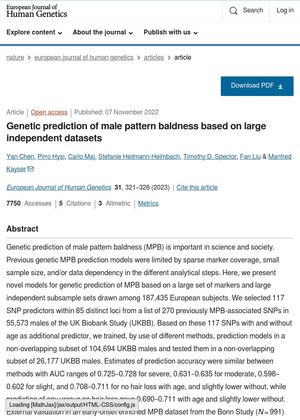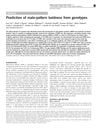Genetic Prediction of Male Pattern Baldness Based on Large Independent Datasets
November 2022
in “
European Journal of Human Genetics
”

TLDR New models predict male pattern baldness better than old ones but still need improvement.
The study developed new genetic prediction models for male pattern baldness (MPB) using large datasets from 187,435 men. Four independent datasets were used for different analytical steps, and 117 Single Nucleotide Polymorphisms (SNPs) from 85 genetic loci were used to build the model. The model was validated in an independent subset of 26,177 males and an external dataset of 991 males from the Bonn Study. The model achieved an Area Under the Receiver Operating Characteristic (AUC) of 0.702 for predicting any vs. no hair loss without considering age, and an AUC of 0.711 when age was included. The model was further validated in an external dataset, achieving an AUC of 0.830 for no hair loss and 0.775 for severe hair loss. The study concludes that these new models provide more accurate and reliable genetic MPB prediction than previous models. However, it acknowledges that it's still a long way towards highly accurate genetic prediction of MPB, suggesting that future models may benefit from additional predicting biomarkers.









